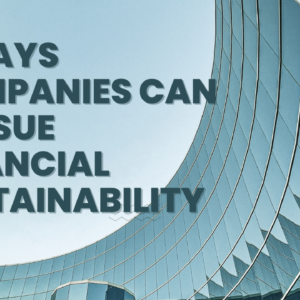In today’s ever-changing business landscape, companies face numerous challenges when it comes to achieving long-term financial sustainability. The pursuit of profitability is not just about making quick gains; it’s about laying a solid foundation that ensures stability, growth, and resilience in the face of adversity. As markets become more competitive and consumer expectations evolve, companies must proactively adapt their strategies to secure their financial future.

This article delves into five essential methods that companies can adopt to achieve financial sustainability. These strategies surpass simple cost-cutting tactics or temporary solutions. Instead, they prioritize the establishment of a strong and enduring financial structure that not only aligns with the company’s goals but also ensures its long-term prosperity.
So, let’s dive in!
Contents
Embracing Innovation and Adaptability
- Innovation as a driving force for financial sustainability
- Encouraging a culture of innovation within the organization
- Investing in research and development to stay ahead of the competition
- Adapting to changing market dynamics and customer preferences
- Monitoring industry trends and consumer behavior
- Being flexible and agile in responding to market shifts
Developing a Diverse Revenue Stream
- The importance of diversification for financial stability
- Exploring new markets and customer segments
- Expanding product or service offerings to cater to different needs
- Strategic partnerships for revenue diversification
- Collaborating with complementary businesses to reach new audiences
- Creating mutually beneficial alliances to expand market reach
Implementing Sustainable Cost Management
- Efficient cost management for long-term financial sustainability
- Conducting a thorough analysis of operational processes and expenses
- Identifying areas for optimization and cost reduction
- Leveraging technology for process automation and efficiency
- Adopting digital solutions to streamline workflows and reduce manual errors
- Implementing cloud-based systems for cost-effective scalability
Investing in Employee Development
- The impact of employee development on financial performance
- Providing training and development opportunities to enhance skills
- Encouraging employee engagement and retention
- Building a culture of continuous learning and innovation
- Fostering a supportive environment that values personal and professional growth
- Promoting cross-functional collaboration and knowledge sharing
Prioritizing Environmental and Social Responsibility
- The business benefits of environmental and social responsibility
- Reducing environmental impact through sustainable practices
- Engaging in corporate social responsibility initiatives
- Attracting conscious consumers and investors
- Meeting the growing demand for environmentally and socially responsible products/services
- Enhancing brand reputation and building trust with stakeholders
Also read:
Freelancing Full-Time? 5 Personal Finance Moves
4 Reasons Why Entrepreneurship is a Lifestyle
Why You Should Buy More Stock When the Economy is Collapsing
3 Ways Location Independent Workers Can Be More Productive in Random Settings
FAQs
Why is financial sustainability important for companies?
The importance of financial sustainability for companies lies in its ability to guarantee their endurance and triumph in the long run. It enables them to navigate through economic uncertainties, adjust to market fluctuations, and sustain profitability consistently as time goes on.
How can companies foster a culture of innovation?
In order to cultivate an environment that nurtures innovation, companies should promote transparent communication, allocate resources for research and development, empower employees to embrace risks, and recognize and incentivize creativity and problem-solving.
What advantages does diversifying revenue streams offer?
Diversifying revenue streams diminishes dependence on a single income source, mitigates risks linked to market fluctuations, and enables companies to explore new markets and customer segments. As a result, it enhances stability and unlocks growth potential.
How can companies implement sustainable cost management practices?
Sustainable cost management involves analyzing operational processes, identifying areas for optimization, adopting efficient technologies, eliminating waste, and continuously monitoring expenses to strike a balance between cost reduction and maintaining quality.
What role does employee development play in financial sustainability?
Employee development is essential for financial sustainability as it enhances skills, boosts employee morale and productivity, fosters innovation, and creates a motivated workforce that contributes to improved financial performance and customer satisfaction.
To emphasize environmental and social responsibility, companies can give precedence to integrating sustainable practices into their operations, minimizing their environmental impact, endorsing social causes, practicing ethical sourcing, and openly communicating their dedication to stakeholders.
Are these strategies applicable to all types of companies?
Yes, these strategies are applicable to various types of companies, regardless of their size or industry. While the implementation may vary, the fundamental principles of pursuing financial sustainability remain relevant across different sectors.
Can pursuing financial sustainability guarantee success?
Pursuing financial sustainability does not guarantee instant success or immunity from challenges. However, it significantly enhances a company’s resilience, adaptability, and long-term prospects, increasing its chances of success in a competitive business landscape.
How often should companies reassess their financial sustainability strategies?
It is essential for companies to periodically evaluate their financial sustainability strategies to ensure they remain aligned with shifting market conditions, technological advancements, and evolving customer requirements. This proactive approach enables them to make necessary adjustments and sustain their financial well-being.
What steps can companies take to measure their financial sustainability progress?
Companies can gauge their progress in achieving financial sustainability by monitoring key performance indicators (KPIs) such as revenue growth, profit margins, return on investment (ROI), cash flow, customer retention, employee satisfaction, and environmental impact. These metrics provide insights into the company’s overall financial health and its alignment with sustainable practices.
Conclusion
To sum up, attaining financial sustainability necessitates a thorough and forward-thinking approach. It entails establishing a sturdy foundation capable of enduring market fluctuations, adjusting to evolving circumstances, and meeting changing customer demands. By embracing innovation, diversifying revenue streams, implementing sustainable cost management practices, investing in employee development, and prioritizing environmental and social responsibility, companies can effectively navigate challenges, seize opportunities, and ensure their financial prosperity in the long run.
Always bear in mind that financial sustainability is not a fixed destination but an ongoing expedition. It demands constant evaluation, adaptation, and a readiness to embrace change. By embracing these strategies, companies can position themselves for enduring success and secure a prosperous future in the ever-evolving business landscape.



